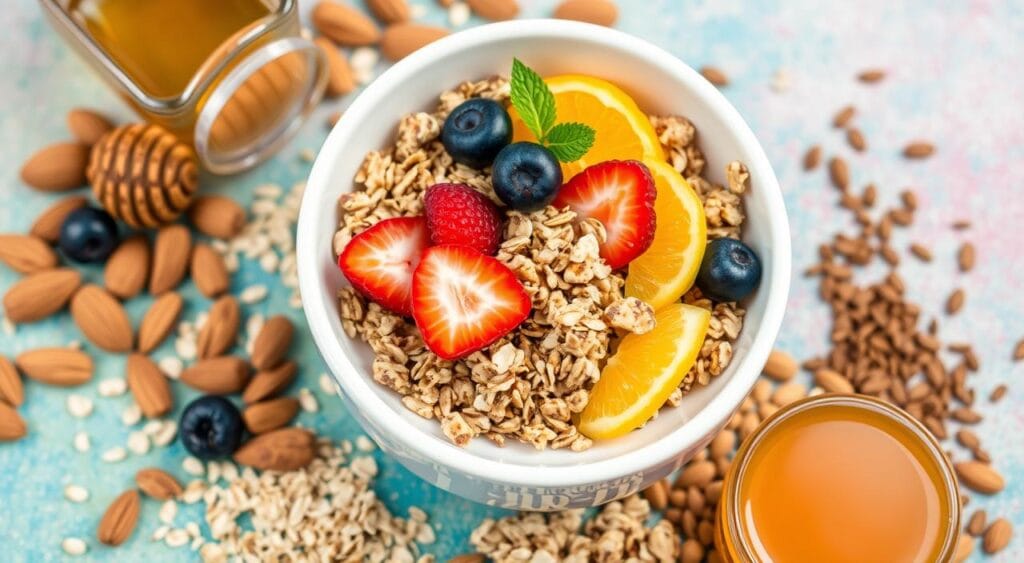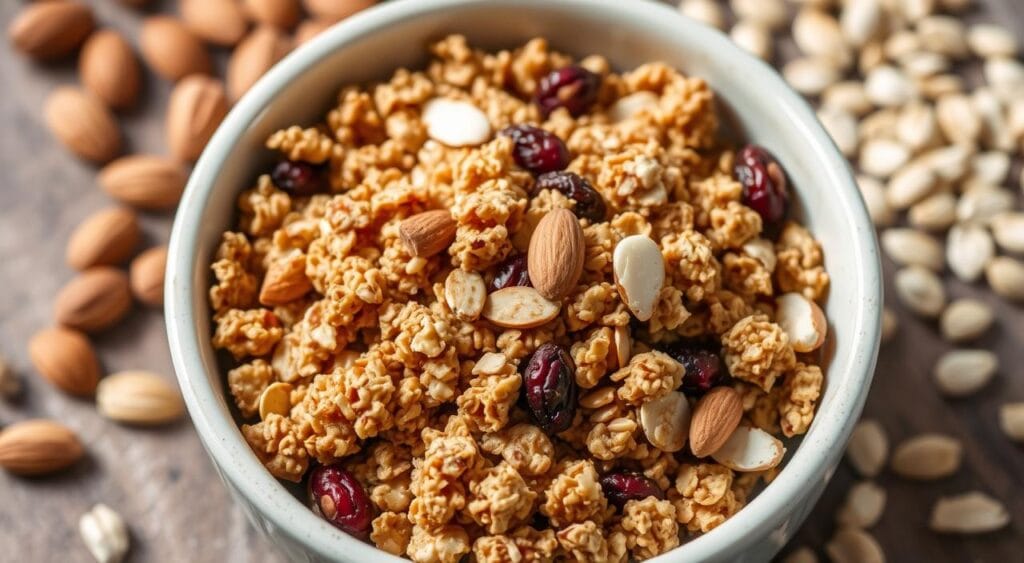Table of Contents
Almond granola is a favorite breakfast choice for those who care about their health. It’s a mix of oats, nuts, and dried fruits. This blend gives you a lot of energy and important vitamins and minerals to start your day.
Exploring almond granola can show you how it fits well into a healthy diet. It makes mornings more enjoyable and nutritious.

Key Takeaways
- Almond granola is a nutrient-dense breakfast option packed with essential macronutrients and micronutrients.
- The combination of oats, almonds, and dried fruits in almond granola offers a well-rounded nutritional profile.
- Almond granola can be a valuable addition to a balanced diet, providing sustained energy and various health benefits.
- Understanding the nutritional facts about almond granola can help you make informed choices for your dietary needs.
- Incorporating almond granola into your daily routine can be a simple and delicious way to support your overall well-being.
Understanding the Nutritional Profile of Almond Granola
The vanilla nut granola recipe is full of good stuff. It’s packed with macronutrients, vitamins, and minerals. These help make a diet balanced and healthy.
Essential Macronutrients in Almond Granola
Almond granola has complex carbs for energy all day. It also has a lot of protein for muscles. Plus, it’s got healthy fats from almonds, which are good for your heart and brain.
Vitamin and Mineral Content
Almond granola is full of vitamins and minerals. It’s rich in vitamin E, which protects cells. It also has B vitamins for energy and nerves. And it has minerals like magnesium, calcium, and iron for bones and muscles.
Caloric Value Per Serving
A serving of almond vanilla nut granola recipe has 150 to 300 calories. Watch your portion sizes to keep your calories in check.

Health Benefits of Including Almond Granola in Your Diet
Adding almond granola to your daily meals can boost your health. It’s not just tasty but also full of vitamins, minerals, and fats good for your heart. These nutrients help keep you healthy and feeling great.
Almond granola is rich in dietary fiber. Fiber is key for a healthy gut, regular bowel movements, and weight control. The mix of oats, nuts, and dried fruit in almond granola keeps you full and satisfied, helping you avoid overeating.
Almonds, a main part of almond granola, are packed with heart-healthy fats. These fats can lower cholesterol, cut down heart disease risk, and keep blood pressure in check. Almonds also have antioxidants that boost heart health, making almond granola a smart choice for heart health.
Almond granola also offers vitamins and minerals like vitamin E, magnesium, and potassium. These nutrients are important for strong bones, a strong immune system, and steady energy. They all help improve your health and well-being.
Adding almond granola to your diet is a tasty and healthy way to start your day or curb a midday hunger. You can enjoy it with milk, on yogurt, or in smoothies. It’s a nutritious way to nourish your body with lots of good nutrients.
“Almond granola is a versatile and nutritious addition to any healthy lifestyle. Its combination of heart-healthy fats, dietary fiber, and essential vitamins makes it a powerhouse of benefits for your overall well-being.”
The Perfect Vanilla Almond Granola Recipe
Try the delicious homemade vanilla almond granola recipe. It’s perfect for a crunchy breakfast or a tasty snack. This granola will quickly become a favorite in your kitchen.
Key Ingredients You’ll Need
- 3 cups rolled oats
- 1 cup raw almonds, chopped
- 1/2 cup light brown sugar
- 1/4 cup maple syrup
- 1/4 cup coconut oil, melted
- 1 teaspoon vanilla extract
- 1/2 teaspoon ground cinnamon
- 1/4 teaspoon salt
Step-by-Step Preparation Guide
1. Preheat your oven to 325°F (165°C). Line a large baking sheet with parchment paper or a silicone baking mat.
2. In a large mixing bowl, mix together the oats, almonds, brown sugar, maple syrup, melted coconut oil, vanilla, cinnamon, and salt. Stir until everything is well mixed.
3. Spread the homemade granola mixture evenly on the prepared baking sheet. Make sure it’s in a single layer.
4. Bake for 20-25 minutes, stirring halfway. The granola should turn golden brown and smell great.
5. Take the granola out of the oven and let it cool completely on the baking sheet. This step helps the granola form clusters and get crunchy.
Storage Tips and Shelf Life
Once it’s cool, put the vanilla almond granola in an airtight container. It remains fresh for up to two weeks when kept at room temperature.For longer storage, keep it in the fridge for up to 1 month.
Enjoy your homemade vanilla almond granola as a healthy breakfast or snack. You can also sprinkle it on yogurt, smoothies, or fruit. The options are endless!
How to Choose the Best Store-Bought Almond Granola
Choosing the right store-bought almond granola is key to a healthy snack. With such a wide variety of options, it’s easy to feel overwhelmed. But, by checking the ingredients and nutrition facts, you can find the best one for you.
Start by looking at the ingredients. Avoid granolas with lots of refined sugars like high fructose corn syrup. Choose ones with almonds, oats, and other whole foods as main ingredients.
Next, check the sugar content per serving. Many granolas have too much sugar, which can cancel out their health benefits. Look for granolas with 8 grams or less of sugar per serving for a healthier choice.
| Granola Brand | Serving Size | Total Sugars (g) | Ingredients |
|---|---|---|---|
| Brand A | 1/2 cup (60g) | 12g | Oats, brown sugar, almonds, honey, coconut oil, cinnamon |
| Brand B | 3/4 cup (85g) | 7g | Oats, almonds, honey, coconut, chia seeds, cinnamon |
| Brand C | 1/2 cup (60g) | 5g | Oats, almonds, maple syrup, coconut oil, vanilla extract |
By carefully checking the ingredient list and sugar content, you can pick a nutritious and tasty granola. This makes for a great snack or breakfast.
Creative Ways to Serve Honey Vanilla Granola
Honey vanilla granola is great for many dishes, from breakfast to dessert. It can make your meals more exciting. Try adding it to your daily routine.
Breakfast Combinations
Begin your day with a tasty breakfast. Mix honey vanilla granola with yogurt or milk. Make a yogurt parfait with Greek yogurt, berries, and granola.
For a smoothie bowl, blend fruits, greens, and milk. Then, add a lot of granola on top.
Snack Ideas and Toppings
- Mix honey vanilla granola with dried fruit, nuts, and seeds for a tasty trail mix.
- Top baked goods like muffins or scones with granola for a nice texture and flavor.
- Add granola to ice cream, frozen yogurt, or oatmeal for extra crunch and sweetness.
- Make your own energy bars or granola bars with granola for a healthy snack.
Honey vanilla granola is very versatile. It can make many dishes better, from breakfast to dessert. It’s a great thing to have in your kitchen.
Understanding Portion Control with Almond Granola
Enjoying almond granola is great, but watching your portions is crucial. This tasty breakfast or snack can quickly add calories if you’re not careful. To stay healthy and avoid weight gain, knowing the right portion sizes is key.
The suggested serving size for almond granola is about 1/2 cup or 60 grams. This amount gives you a good mix of carbs, fats, and protein without too many calories. But remember, everyone’s calorie needs are different. This depends on your age, gender, how active you are, and your health goals.
| Serving Size | Calories | Protein | Fat | Carbohydrates |
|---|---|---|---|---|
| 1/2 cup (60g) | 300 kcal | 8g | 18g | 32g |
| 1 cup (120g) | 600 kcal | 16g | 36g | 64g |
When you add almond granola to your diet, keep an eye on your portions. Pair it with other healthy foods. For instance, try a 1/2 cup of granola with a cup of Greek yogurt and some fresh berries. This mix offers protein, fats, fiber, and vitamins and minerals.
Being mindful of your portion control and serving size with almond granola helps keep your calorie intake in check. This supports your overall health and wellness goals.
Comparing Homemade vs. Commercial Vanilla Nut Granola
Choosing between vanilla nut granola made at home or bought in stores can be hard. Both have their good points, and knowing the cost and health differences helps you decide.
Cost Analysis
At first, store-bought granola might seem cheaper. But, homemade granola can be more cost-effective when you look at the price per serving. Buying ingredients in bulk lets you make a big batch of vanilla nut granola for less money than a pre-made brand.
Nutritional Differences
The health benefits of homemade vs. store-bought vanilla nut granola are different. Homemade granola lets you pick the ingredients, so you can avoid extra sugars and use better oils. You can also add more nuts and seeds. On the other hand, store-bought vanilla nut granola might have more added sugars, oils, and preservatives to last longer.
In the end, whether to make vanilla nut granola at home or buy it depends on what you like, your diet, and how much time you have. By looking at the cost and health benefits, you can choose what’s best for you.
Common Mistakes to Avoid When Making Almond Granola
Making homemade almond granola can be fun and rewarding. However, it brings along its own unique challenges. Issues like overbaking and uneven mixing can ruin your batch. Don’t worry, with some tips, you can make delicious granola every time.
One big mistake is overbaking the granola. This makes it dry and crumbly. To avoid this, watch it closely and take it out when it’s golden brown.
- Make sure the granola is spread evenly on the baking sheet.
- Use a timer and stir it often to prevent uneven browning.
- Adjust the oven temperature and time to get the best results.
Not mixing the ingredients well is another problem. This can make some bites too sweet or crunchy. To fix this, mix everything well before baking.
| Common Granola-Making Mistakes | Solutions |
|---|---|
| Overbaking | Monitor baking time, check regularly, adjust temperature and time as needed |
| Uneven mixing of ingredients | Thoroughly combine dry and wet ingredients for even distribution |
| Improper storage | Store granola in an airtight container, avoid exposure to air and moisture |
Storing granola properly is also important. If you don’t store it right, it can get stale. Keep it in a sealed jar or bag, and store it in the fridge or freezer for longer.
By avoiding these common mistakes, you can make delicious almond granola. It will taste great and impress everyone.
Dietary Considerations and Modifications
Enjoying almond granola can be a treat for everyone. But, those with dietary needs have special requirements. Luckily, you can make this tasty snack fit many diets.
Gluten-Free Options
For those on a gluten-free diet, finding the right granola can be hard. But, making gluten-free almond granola is easy. Just use gluten-free oats and add nuts, seeds, and dried fruits.
Sugar-Free Variations
Want to cut down on sugar? There are many sugar-free almond granola recipes. Use natural sweeteners like stevia or monk fruit instead of honey or maple syrup. These sweeteners add flavor without sugar.
| Dietary Consideration | Granola Modification |
|---|---|
| Gluten-Free | Use certified gluten-free oats and other naturally gluten-free ingredients |
| Sugar-Free | Substitute traditional sweeteners with low-glycemic natural alternatives like stevia or monk fruit |
Knowing your family’s dietary needs helps you plan meals better. You can make gluten-free granola and sugar-free granola for everyone. This way, everyone can enjoy this tasty breakfast and snack.
The History and Evolution of Granola
Granola, a favorite breakfast cereal, has a rich history. It started in the late 19th century. It has changed with nutritional trends, becoming a key part of today’s health-conscious diet.
Dr. James Caleb Jackson invented granola in 1863 at his New York health spa. His creation, called “granula,” is the base of today’s granola.
In the late 1800s, Dr. John Harvey Kellogg improved granola. He added rolled oats, nuts, and honey to his version. Kellogg’s granola became popular, especially among health-conscious and vegetarian groups.
The 1960s and 1970s hippie culture boosted granola’s popularity. People started making their own granola at home. This reflected the era’s focus on natural and organic foods.
Over time, granola’s popularity grew. Commercial brands introduced many flavors. Today, it’s a favorite breakfast and snack, known for its health benefits and versatility.
Granola’s journey from a health food to a beloved breakfast shows the power of innovation. It highlights the lasting appeal of wholesome, nourishing foods.
“Granola has become a symbol of health and wellness, reflecting the changing attitudes towards nutrition and the desire for wholesome, natural foods.”
| Year | Event | Impact |
|---|---|---|
| 1863 | Dr. James Caleb Jackson invents “granula” | Lays the foundation for modern granola |
| Late 1800s | Dr. John Harvey Kellogg develops his own granola recipe | Popularizes granola as a health food |
| 1960s-1970s | Granola gains popularity during the hippie movement | Homemade granola becomes a staple in many households |
| Today | Granola becomes a mainstream breakfast and snack food | Diverse flavors and variations cater to evolving consumer preferences |
Conclusion
Almond granola is a nutritious and versatile breakfast option. It’s packed with essential nutrients that help kickstart your day. This makes it an excellent option for a healthy beginning.
Whether you make it at home or buy it, almond granola is full of benefits. It supports heart health and helps with weight management. It’s a great addition to your wellness journey.
Granola’s popularity is growing, leading to new recipes and methods. This means you can try different flavors and nutritional options. Enjoying almond granola in moderation is key to a balanced, healthy lifestyle.
FAQ
What are the essential macronutrients in almond granola?
Almond granola is packed with protein, complex carbs, and healthy fats. It’s made with oats, almonds, and other nuts and seeds. This mix gives you a balanced diet.
What vitamins and minerals are found in almond granola?
Almond granola is full of vitamins and minerals. You’ll find vitamin E, magnesium, potassium, and iron. These nutrients help your immune system, bones, and energy levels.
How many calories are in a serving of almond granola?
Almond granola’s calories depend on the recipe and ingredients. A 1/2 cup (60g) serving has about 300-350 calories.
What are the health benefits of including almond granola in my diet?
Eating almond granola can boost your heart health with its fats. It also aids digestion and may help with weight management. This is thanks to its protein, fiber, and complex carbs.
What are the key ingredients needed to make vanilla almond granola at home?
To make vanilla almond granola, you need rolled oats, sliced almonds, and sweeteners like honey or maple syrup. Add vanilla extract and a pinch of salt. You can also add dried fruit, coconut, or seeds.
How should I store homemade vanilla almond granola to maintain freshness?
Store homemade vanilla almond granola in an airtight container at room temperature. This keeps it crunchy. It stays fresh for 1-2 weeks.
What should I look for when purchasing store-bought almond granola?
When buying almond granola, check the ingredients and nutrition facts. Choose options with less sugar and no artificial additives. Look for more nuts and whole grains.
How can I incorporate honey vanilla granola into my meals and snacks?
Enjoy honey vanilla granola on yogurt parfaits, smoothie bowls, or oatmeal. It’s great as a snack or in trail mixes. You can also use it on baked goods or in salads.
How can I ensure I’m consuming the appropriate portion size of almond granola?
Be mindful of portion sizes with almond granola. A 1/2 cup (60g) serving has 300-350 calories. Eating too much can lead to too many calories, so measure your portions.
What are the main differences between homemade and commercial vanilla nut granola?
Homemade granola is cheaper and lets you control ingredients. It’s often more nutritious. Commercial granola is convenient but might have more sugar or preservatives.
What are some common mistakes to avoid when making almond granola at home?
Avoid overbaking, which can make the granola dry. Also, mix ingredients well to ensure even baking. Store it in an airtight container to keep it crunchy.
Are there any gluten-free or sugar-free options for almond granola?
Yes, you can make almond granola gluten-free or sugar-free. Use gluten-free oats and natural sweeteners like stevia or erythritol instead of honey or maple syrup.
How has granola evolved over time?
Granola started as a health food in the late 19th century. It has changed with cultural and health trends. Now, it comes in many flavors and is used in various dishes.


3 comments
[…] Granola Guide What is Carob and Why Use it for… How to Make Hillbilly Fish Fry Seasoning at… Almond Granola Nutrition How to Make Carob Dipped Strawberries at Home:… Vanilla granola benefits Vanilla Nut Granola […]
[…] Granola Guide What is Carob and Why Use it for… How to Make Hillbilly Fish Fry Seasoning at… Almond Granola Nutrition How to Make Carob Dipped Strawberries at Home:… Vanilla granola benefits Vanilla Nut Granola […]
[…] Granola Guide What is Carob and Why Use it for… How to Make Hillbilly Fish Fry Seasoning at… Almond Granola Nutrition How to Make Carob Dipped Strawberries at Home:… Vanilla granola benefits Vanilla Nut Granola […]
Comments are closed.